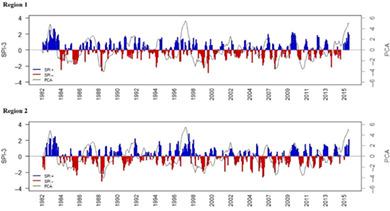当前位置:
X-MOL 学术
›
Int. J. Climatol.
›
论文详情
Our official English website, www.x-mol.net, welcomes your
feedback! (Note: you will need to create a separate account there.)
Spatio-temporal variability of wet and drought events in the Paraná River basin—Brazil and its association with the El Niño—Southern oscillation phenomenon
International Journal of Climatology ( IF 3.5 ) Pub Date : 2021-03-19 , DOI: 10.1002/joc.7104 Eliane Barbosa Santos 1, 2 , Edmilson Dias Freitas 1 , Sameh Adib Abou Rafee 1 , Thais Fujita 1 , Anderson Paulo Rudke 3 , Leila Droprinchinski Martins 3 , Rodrigo Augusto Ferreira de Souza 4 , Jorge Alberto Martins 3
International Journal of Climatology ( IF 3.5 ) Pub Date : 2021-03-19 , DOI: 10.1002/joc.7104 Eliane Barbosa Santos 1, 2 , Edmilson Dias Freitas 1 , Sameh Adib Abou Rafee 1 , Thais Fujita 1 , Anderson Paulo Rudke 3 , Leila Droprinchinski Martins 3 , Rodrigo Augusto Ferreira de Souza 4 , Jorge Alberto Martins 3
Affiliation

|
This study aimed to analyse the spatio-temporal variability of wet and drought events in the Paraná River Basin and their association with the El Niño—Southern 20 Oscillation (ENSO) phenomenon. A dataset of daily precipitation from 953 pluviometric stations from 1982 to 2016 was used. Anomalies of sea surface temperature (SST) from the four Niño regions of the Equatorial Pacific were also used. Homogeneous rainfall regions were defined using cluster analysis and principal component analysis (PCA). To describe the drought or wet conditions the standardized precipitation index (SPI) for 1-, 3-, and 12-months time scales were used. The relationship between the ENSO and the wet and drought conditions were also analysed. The results suggest that two regions are enough to represent the whole Paraná River Basin during different rainfall patterns. In the 1-month SPI, the precipitation extremes of the region that is mainly composed of the state of Paraná and southern region of Mato Grosso do Sul (Region 2), showed a statistically significant correlation at the level of 1% with ENSO events. In the 12-month SPI, the most intense drought and wet events and with greater spatial coverage, in general, were observed in years with ENSO occurrences. In general, it is observed that although the ENSO phenomenon is not the main factor that causes the drought and wet events in the region, El Niño contributes to the rainfall excess and La Niña to the rainfall deficit in the Paraná River Basin.
中文翻译:

巴西巴拉那河流域湿旱事件的时空变化及其与厄尔尼诺现象的关联——南方振荡现象
本研究旨在分析巴拉那河流域潮湿和干旱事件的时空变异性及其与厄尔尼诺 - 南方 20 度涛动 (ENSO) 现象的关联。使用了 1982 年至 2016 年 953 个雨量站的日降水数据集。还使用了赤道太平洋四个尼诺地区的海面温度 (SST) 异常。使用聚类分析和主成分分析 (PCA) 定义均匀降雨区域。为了描述干旱或潮湿条件,使用了 1、3 和 12 个月时间尺度的标准化降水指数 (SPI)。还分析了ENSO与潮湿和干旱条件之间的关系。结果表明,在不同的降雨模式下,两个区域足以代表整个巴拉那河流域。在 1 个月的 SPI 中,主要由巴拉那州和南马托格罗索州南部地区(区域 2)组成的地区的降水极端事件与 ENSO 事件显示出 1% 水平的统计显着相关性。在 12 个月的 SPI 中,通常在发生 ENSO 的年份中观察到最严重的干旱和潮湿事件以及更大的空间覆盖范围。总的来说,观察到虽然ENSO现象不是导致该地区干旱和潮湿事件的主要因素,但厄尔尼诺现象导致了巴拉那河流域的降雨量过剩和拉尼娜现象。与 ENSO 事件在 1% 的水平上显示出统计学上的显着相关性。在 12 个月的 SPI 中,通常在发生 ENSO 的年份中观察到最严重的干旱和潮湿事件以及更大的空间覆盖范围。总的来说,观察到虽然ENSO现象不是导致该地区干旱和潮湿事件的主要因素,但厄尔尼诺现象导致了巴拉那河流域的降雨量过剩和拉尼娜现象。与 ENSO 事件在 1% 的水平上显示出统计学上的显着相关性。在 12 个月的 SPI 中,通常在发生 ENSO 的年份中观察到最严重的干旱和潮湿事件,并且空间覆盖范围更大。总的来说,观察到虽然ENSO现象不是导致该地区干旱和潮湿事件的主要因素,但厄尔尼诺现象导致了巴拉那河流域的降雨量过剩和拉尼娜现象。
更新日期:2021-03-19
中文翻译:

巴西巴拉那河流域湿旱事件的时空变化及其与厄尔尼诺现象的关联——南方振荡现象
本研究旨在分析巴拉那河流域潮湿和干旱事件的时空变异性及其与厄尔尼诺 - 南方 20 度涛动 (ENSO) 现象的关联。使用了 1982 年至 2016 年 953 个雨量站的日降水数据集。还使用了赤道太平洋四个尼诺地区的海面温度 (SST) 异常。使用聚类分析和主成分分析 (PCA) 定义均匀降雨区域。为了描述干旱或潮湿条件,使用了 1、3 和 12 个月时间尺度的标准化降水指数 (SPI)。还分析了ENSO与潮湿和干旱条件之间的关系。结果表明,在不同的降雨模式下,两个区域足以代表整个巴拉那河流域。在 1 个月的 SPI 中,主要由巴拉那州和南马托格罗索州南部地区(区域 2)组成的地区的降水极端事件与 ENSO 事件显示出 1% 水平的统计显着相关性。在 12 个月的 SPI 中,通常在发生 ENSO 的年份中观察到最严重的干旱和潮湿事件以及更大的空间覆盖范围。总的来说,观察到虽然ENSO现象不是导致该地区干旱和潮湿事件的主要因素,但厄尔尼诺现象导致了巴拉那河流域的降雨量过剩和拉尼娜现象。与 ENSO 事件在 1% 的水平上显示出统计学上的显着相关性。在 12 个月的 SPI 中,通常在发生 ENSO 的年份中观察到最严重的干旱和潮湿事件以及更大的空间覆盖范围。总的来说,观察到虽然ENSO现象不是导致该地区干旱和潮湿事件的主要因素,但厄尔尼诺现象导致了巴拉那河流域的降雨量过剩和拉尼娜现象。与 ENSO 事件在 1% 的水平上显示出统计学上的显着相关性。在 12 个月的 SPI 中,通常在发生 ENSO 的年份中观察到最严重的干旱和潮湿事件,并且空间覆盖范围更大。总的来说,观察到虽然ENSO现象不是导致该地区干旱和潮湿事件的主要因素,但厄尔尼诺现象导致了巴拉那河流域的降雨量过剩和拉尼娜现象。











































 京公网安备 11010802027423号
京公网安备 11010802027423号